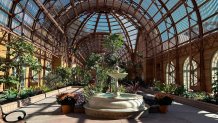After 3 years closed to the public, San Diego's iconic Botanical Building will finally reopen after finishing phase 1 of a $28.5 million revitalization project.
Under construction since 2022, Forever Balboa Park and the City of San Diego announced it will reopen to the public on Dec. 6, just in time for December Nights.
It will reopen with limited hours. On Dec. 6, it will open from 1 to 7 p.m. and Dec. 7 from 12 to 6 p.m. The Botanical Building will remain free and open to the public.
The renovation included restoring historic elements including stucco arcades, a new redwood lath roof, water-saving irrigation systems, new LED lighting, improved access for persons with disabilities, adding a flexible education and programming space, and the restoration of the historic urns and balustrades.
Get top local stories in San Diego delivered to you every morning. >Sign up for NBC San Diego's News Headlines newsletter.





Now, the renovation project is moving into Phase 2 that will restore, reconstruct and revitalize the Botanical Building's exterior gardens. This means the walkways around the building will be improved, the gardens and irrigation surrounding the building will also be improved, and the pergola that stood on the west lawn near The San Diego Museum of Art will be reconstructed along with two other exterior fountains, according to a release.
About the Balboa Park Botanical Building & Gardens
The iconic structure was built in 1914, in time for the Panama-California Exposition the following year. The renovation project aims to repair more than a century’s worth of issues like rust and corrosion, wood rot and termite damage. The project will also improve accessibility and make the building better able to support crowds, as well as update the irrigation, plumbing and lighting systems.
The project will cost $28.5 million, paid for by a patchwork of city, state, federal and private funding. It was initially expected to cost around $21 million, but that figure went up by $7 million “due to a combination of inflation, material cost increases and added construction to address some of the unforeseen needs that were discovered,” according to a city spokesman.
Those additional, unanticipated construction needs also elongated the project’s schedule, according to the city.
The Botanical Building is home to more than 2,100 plants, most of which were moved to an offsite nursery during the reconstruction.



